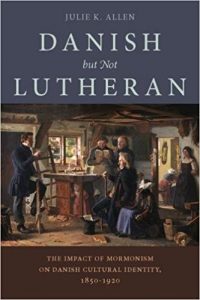 Title: Danish, But Not Lutheran
Title: Danish, But Not Lutheran
Author: Julie K. Allen
University of Utah Press, 2017. 316 pages.
Reviewed by Peter Wilson, November 2019.
Danish, But Not Lutheran begins with an overview of the controversy and arguments surrounding the inclusion of freedom of religion in Denmark’s 1849 Constitution, which in turn allowed Mormonism to thrive in the latter half of the 19th century in Denmark. The book then investigates intellectual and popular media responses to Mormonism’s flourishing in Denmark in 1850-1920.
Allen introduces us to a fascinating aristocratic author named Elise Stampe who published from 1850-1876. She wrote, but never published, a 400 page manuscript about Mormonism. Stampe had a close friend who had joined the Church of Jesus Christ of Latter-day Saints and she seems to be quite fascinated with the movement. Her conclusions about the Church were anthropologically shrewd, and more thorough than others made at the time (for example, she quotes the the Doctrine and Covenants and Parley P. Pratt in her manuscript). For me, Elise Stampe was the most interesting character in the book and I wish there was more about her.
One intellectual who was more antagonistic to the Church was Peter Kierkegaard, the philosopher Soren Kierkegaard’s brother, who was a bishop in the state-sponsored Lutheran church. He had written in his journal about debating missionaries and even published his speech “About and Against Mormonism” in a Danish church newspaper. One argument that the Bishop made against Mormonism specifically targeted the teaching of apostasy. He argued that every heretical group always makes claims of apostasy, but he warns that if we do accept that claim, it “destroys our faith in (Christ) . . . if we let ourselves be seduced into believing that the Church (Christ) founded has been destroyed” (95).
While the more famous Kierkegaard did not address Mormonism exactly, Soren Kierkegaard’s rejection of the state-endorsed Lutheran church and his criticism of the practice of infant baptisms likely gave some intellectual backing to religious movements that were not sponsored by the states.
Popular media, including street ballads and silent film, often mocked or portrayed Mormonism as dangerous in the aforementioned time period. These media emphasized Mormonism’s Americanism and polygamist practice. A documentary “The White Slave Trade” which depicted sex slavery was a box-office success in Denmark in 1910. Eager to replicate that success, films about Mormons were made in The White Slave Trade’s image depicting LDS priests and missionaries hoodwinking young women and adding them to their harem.
The book also includes some fun anecdotes of different Danish emigrants. Frederik Samuelsen, one of the profiled emigrants, was the first Mormon politician outside of America prior his emigration. As Mormonism in Denmark thrived among the lower class, it isn’t surprising that as a member of Denmark’s lower Parliament, he was a member of the Social Democratic Party, supported welfare reforms, and had a background in labor unions.
I also learned from some of the other vignettes that in 19th century Mormonism both polygamy and the Word of Wisdom were more optional than I had previously thought.

I’m glad you found the book interesting, Peter! Since you found Elisa Stampe fascinating (as I did as well), I wanted to let you know that I’m planning on publishing a transcription/translation of her whole book in a couple of years. I’ll keep you posted!
That’s awesome! I’ll be looking forward to it.